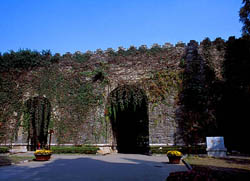
After heated public debate and appeals from cultural experts,
authorities in Nanjing have announced that a subway station will
not be built under the ancient Ming Palace.
The government of Nanjing ruled on Monday that the subway
station between the Daxingong and Zhongshan Gate section of the No
2 metro line, which is under construction, will now be built on the
campus of Nanjing University of Aeronautics and Astronautics
(NUAA).
The city's communications authorities initially announced this
May that the station would be built right under the centre of the
ancient Ming Palace, saying that it would be convenient for
passengers to change to other subways or buses.
This plan was strongly criticized by cultural heritage
experts.
The original version of the Forbidden City in Beijing, the
palace for Ming and Qing (1644-1911) emperors, the Ming palace in
Nanjing is considered a symbol of the city's long history of
culture and civilization.
"Being 300 meters away from the original site, the new station
avoids destroying the Ming Dynasty (1388-1644) heritage, a concern
of many citizens," an official surnamed Zhou with the city's
Publicity Bureau told China Daily.
The country's State Administration of Cultural Heritage (SACH)
in June recommended the station be moved, after the 600-year-old
site was promoted to national-level protection status on June
10.
It was reported by Xinhua News Agency that SACH suggested
authorities in Nanjing, now capital of East China's Jiangsu Province, re-route the subway around
the protection zone, prompting Nanjing Municipal Government to
choose the NUAA site.
According to Pan Guxi, a senior architecture expert with
Nanjing-based Southeast University, as well as the ancient
buildings on the surface, researchers in 2000 found a huge building
cluster dating from the Ming Dynasty (1368-1644) buried three to
six meters under the ground.
"If the original proposal was approved, the construction team
would have to dig a 10,000-square-metre hole in order to
accommodate the four entrances to the station, which undoubtedly
would divide the ancient underground cluster into two parts," said
Pan.
Local people welcomed the news. "History is very important, we
cannot give it up just for modern development," said Chen Liangwei,
32, a bookstore employee.
"If we do, in the future the city will have no memory."
The No 2 metro line, construction of which started last
December, will be 21.4 kilometers in length and is expected to be
completed by 2009.
Due to continuous disputes over the site selection of the Ming
Palace station, construction of the station has been delayed for a
month.
"Luckily we have already prepared a construction plan for the
NUAA site, and we will adjust the whole schedule to make up for
lost time," said an official surnamed Zhang with the Nanjing Subway
Construction Commanding Commission.
Although the ancient palace has now been saved from being
divided, experts warned that more historic sites will be destroyed
if attention is not paid.
"As a city with a history exceeding 2,700 years, ancient culture
and modern construction are frequently in conflict," said Yi
Zhiqiang, an official from the Nanjing Bureau of Cultural
Relics.
For example, the No 2 metro line is expected to pass through six
cultural relic areas in the city.
"Properly locating metro stations in order to avoid damage to
ancient treasures will be a challenge," said Yi.
According to Yi, construction of the subway will be suspended if
significant historic relics are discovered.
(China Daily August 2, 2006)

